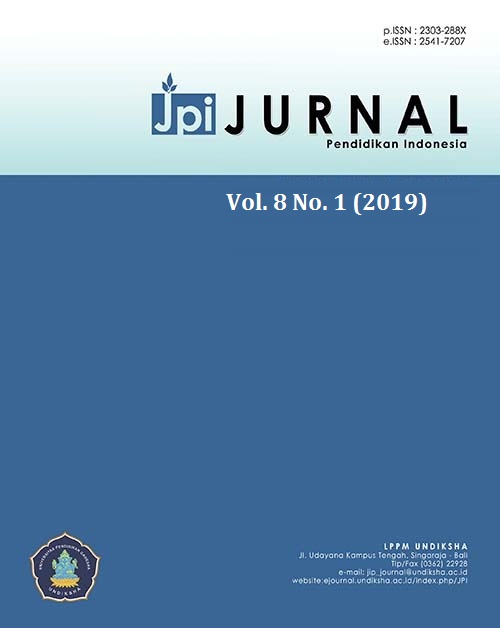Improving Written Communication Skills and Mathematical Disposition of Tenth Grade IPS 4 Students by Using Think-Talk-Write (TTW) Learning Strategy at SMAN 50 Jakarta
DOI:
https://doi.org/10.23887/jpi-undiksha.v8i1.14990Keywords:
mathematics written communication ability, mathematic disposition ability, Think-Talk Write (TTW) learning strategyAbstract
The aim of this research was to improve mathematical written communication and mathematical disposition of students by using think-talk-write (TTW) learning strategy in tenth grade IPS 4 students at SMAN 50 Jakarta 2017/2018 academic year. The design of this study was a classroom action research. The subject of this research consists of 6 students, 2 students with low written communication skills with moderate disposition skills, 2 students having medium-skilled and medium disposition ability and 2 students who have high disposition ability with medium and high disposition ability. The data collection techniques were consist of 1) Giving mathematics written communication ability test, 2) Spreading mathematic disposition questionnaire, 3) Doing filed notes, 4) Interviewing with the research subjects. The result was based on the end of the third cycle, it was obtained all subject experienced has increase in mathematical written communication ability and 4 out of 6 subjects experienced has increase in mathematical disposition ability. Based on the results, it can be concluded that the TTW learning strategy can increase mathematical written communication and mathematical disposition ability in tenth grade IPS 4 students at SMAN 50 Jakarta 2017/2018 academic year. In this research, an improvement made at the thinking stage was to write answers on the worksheet so that students will be more passionate about thinking of how to solve problems. On the talking stage, students were not only explaining completion but also helping team members who having difficulties. On the write stage, students could write the answer using their own phrase so that they will understand more about the completion based on observations and the results of questionnaires to increase the ability of mathematical disposition it can be seen that students experience increased self-confidence in explaining the ideas obtained, able to solve problems in various ways and have the willingness to solve mathematical problems. Besides, when the teacher asks students to re-examine the result of the work, it can be seen that students check their work while checking if there was a problem-solving problem.References
Andriani R, Isrok’atun, Kurniadi Y. 2016. “Pendekatan Realistic Mathematics Education Untuk Menigkatkan Kemampuan Koneksi Matematis dan Disposisi Matematis Siswa”. Jurnal Pena Ilmiah. Vol.1. No.1: 991-1000.
Ansari, B. I. 2015. Komunikasi Matematik Strategi Berfikir dan Manajemen Belajar. Banda Aceh: Penerbit Pena.
Cai J, Lane S, Jacebsin MS. 1998.“Assessing Students Mathematical Communication“. School Science and Mathematics Journal. Vol. 96. No. 5: 238-246.
Choridah DT. 2013. “Peran Pembelajaran Berbasis Masalah untuk Meningkatkan Kemampuan Komunikasi dan Berpikir Kreatif serta Disposisi Matematis Siswa SMA”. Jurnal Ilmiah Program Studi Matematika STKIP Siliwangi Bandung. Vol.2. No.2: 194-202.
Elida N. 2012. “Meningkatkan Kemampuan Komunikasi Matematika Siswa Sekolah Menengah Pertama Melalui Pembelajaran THINK-TALK-WRITE (TTW)”. Jurnal Ilmiah Program Studi Matematika STKIP Siliwangi Bandung. Vol.1. No.2: 178-185.
Hamdani. 2009. “Pengembangan Pembelajaran Dengan Mathematical Discourse dalam Meningkatkan Kemampuan Komunikasi Matematik pada Siswa Sekolah Menengah Pertama”. Prosiding UNY. ISBN : 978-979-16353-3-2: 163-173.
Muriana, Hasratuddin. 2014. “Peningkatan Kemampuan Komunikasi dan Disposisi Matematik Siswa SMA di Kecamatan Medan Area dengan Menggunakan Model Pembelajaran Kooperatif Tipe Grup Investigation”. Pendidikan Matematika Paradikma. Vol 7 No. 1: 87-101.
Paradita Y, Sukasno, Wahyuni R. 2016.“Penerapan Strategi THINK-TALK- WRITE (TTW) Terhadap Kemampuan Pemahaman Konsep Matematika Siswa Kelas VIII SMP Negeri Muara Beliti Tahun Pelajaran 2016/2017“. Artikel Ilmiah STKIP- PGRI Lubuklinggau.
Salmaniah F, Yusmin E, Nursangaji A. 2015. “Disposisi Siswa Ditinjau dari Kemampuan Problem Solving. Vol.5 No.6: 1-12.
Sopiany HN., Hijjah IS. 2016.“ Penggunaan Strategi TTW (THINK- TALK- WRITE) dengan Pendekatan Kontekstual dalam Meningkatkan Kemampuan Pemecahan Masalah dan Disposisi Matematis Siswa MTsN Rawamerta Karawang”. JPPM. Vol.9. No. 2: 268-276.
Sumirat LA. 2014. “Efektifitas Strategi Pembelajaran Kooperatif Tipe Think- Talk- Write (TTW) Terhadap Kemampuan Komunikasi dan Disposisi Matematis Siswa”. Jurnal Pendidikan dan Keguruan. Vol 1. No.2: 21-29.
Suyanto E. 2016. “Pembelajaran Matematika dengan Strategi TTW Berbasis Learning Journal untuk Meningkatkan Kemampuan Menulis Matematis”. Jurnal Matematika Kreatif- Inovatif. Vol.7 No. 1. 58-65.
Syaban M. 2009. “ Menumbuhkembangkan Daya dan Disposisi Matematis Siswa Sekolah Menengah Atas Melalui Pembelajaran Investigasi. Jurnal EDUCATIONIST. Vol.III. No.2: 129-136.
Taufiq. 2017. “Pendekatan Kontekstual dan Strategi Think-Talk-Write untuk Meningkatkan Kemampuan Pemecahan Masalah dan Disposisi Matematik Siswa SMP”. Jurnal Numeracy. Vol. 4. No. 1: 1-13.
Wijaya HPI., Sujadi I, Riyadi. 2016. “Kemampuan Komunikasi Matematis Siswa Sesuai dengan Gender dalam Pemecahan Masalah pada Materi Balok dan Kubus (Studi Kasus pada Siswa SMP Kelas VIII SMP Islam Al- Azhar 29 Semarang)”. Elektronok Pembelajaran Matematika. Vol. 4 No. 41. November 2016: 778-788.
Downloads
Published
Issue
Section
License
Authors who publish with the Jurnal Pendidikan Indnesia agree to the following terms:
- Authors retain copyright and grant the journal the right of first publication with the work simultaneously licensed under a Creative Commons Attribution License (CC BY-SA 4.0) that allows others to share the work with an acknowledgment of the work's authorship and initial publication in this journal.
- Authors are able to enter into separate, additional contractual arrangements for the non-exclusive distribution of the journal's published version of the work (e.g., post it to an institutional repository or publish it in a book), with an acknowledgment of its initial publication in this journal.
- Authors are permitted and encouraged to post their work online (e.g., in institutional repositories or on their website) prior to and during the submission process, as it can lead to productive exchanges, as well as earlier and greater citation of published work. (See The Effect of Open Access)








